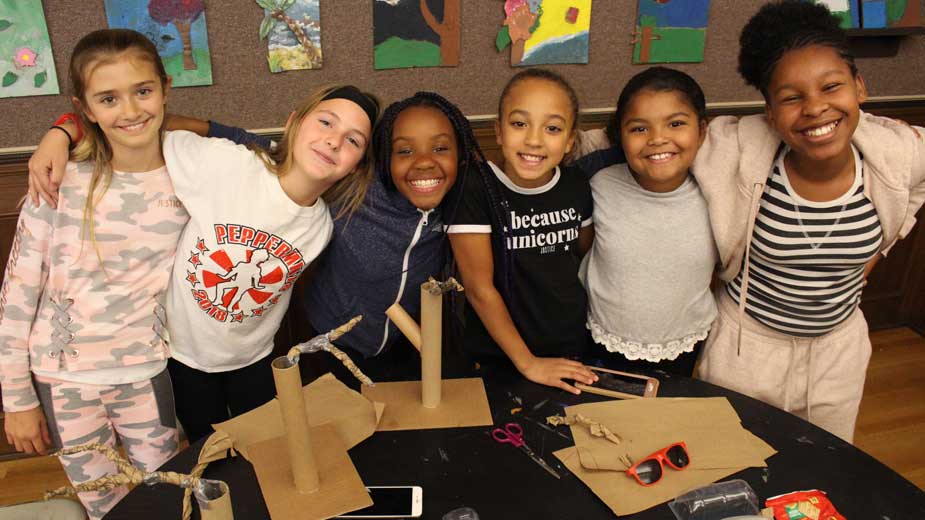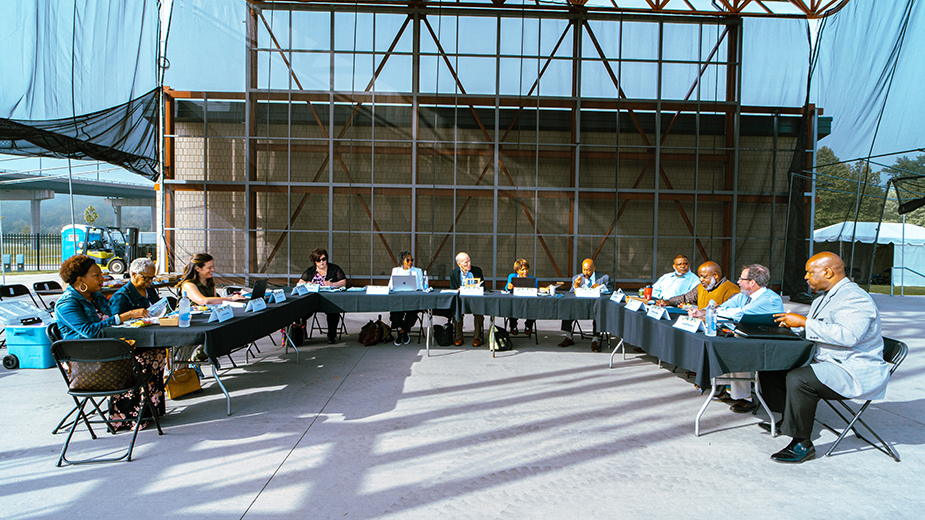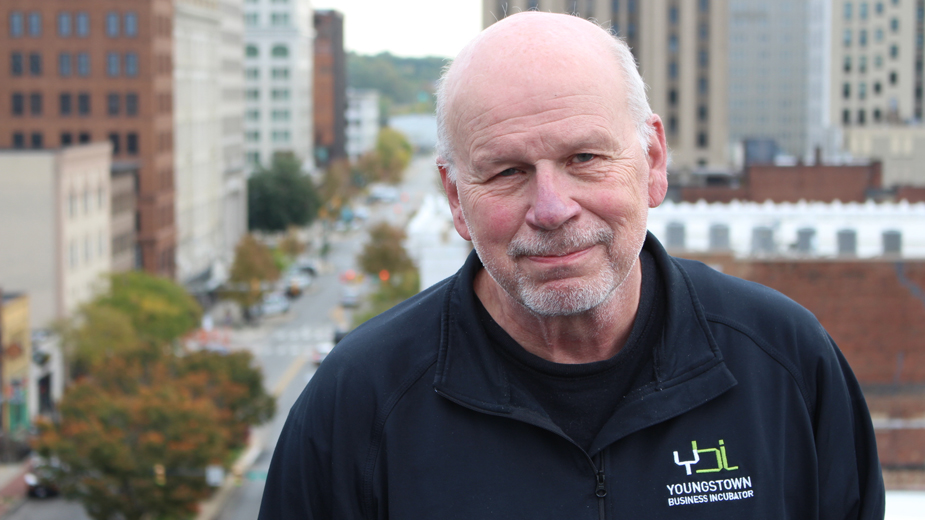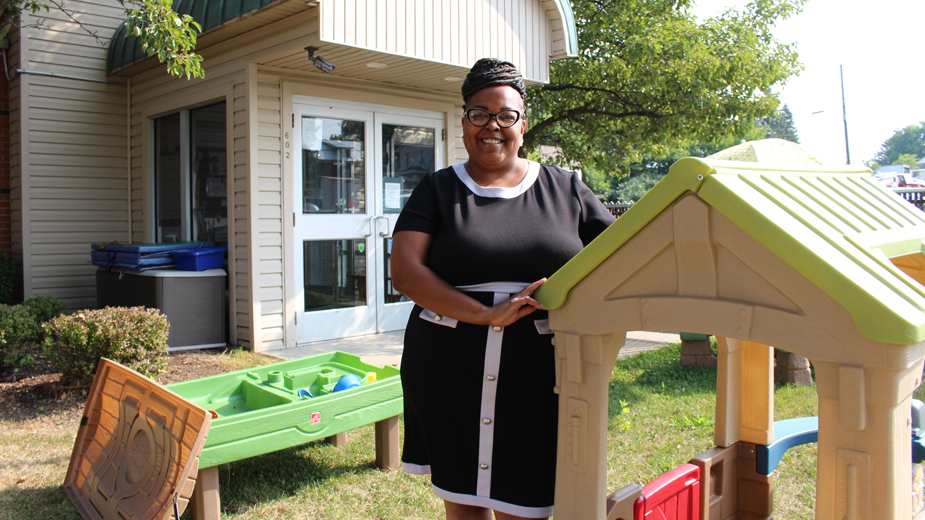Hoyt Center Mixes the Arts with Purpose
NEW CASTLE, Pa. — It takes several minutes of walking – mostly uphill – for Carol Daviei to get from her car to her watercolor class at the Hoyt Center for the Arts.
Using a walker, she moves slowly down the sidewalk to the front door. From there she heads up a long, narrow hallway to get to the elevator that will take her to the third floor. “It’s a lot of work. It’s like a mile-long walk, but it’s worth it to me,” she says, now sitting comfortably in the classroom.
Daviei has been coming to the class for four weeks to learn how to paint, but also for the camaraderie. “When you’re handicapped, if you don’t keep going, you just sit at home, which is no good,” she says.
One day, Daviei pulled Hoyt Executive Director Kimberly Koller-Jones aside to tell her how valuable she considers her time at the Hoyt to be. “She said if she couldn’t come here, she didn’t know what she’d do,” says Koller-Jones.
Daviei is one of several thousand people who will take part in programming the Hoyt provides this year.
The mission of the Hoyt, which opened in New Castle, Pa., in 1965, is to “expand and enrich the life of the community through participation in the arts,” Koller-Jones says.
Koller-Jones was hired as executive director 23 years ago. “I had just enrolled in a master’s program in architectural preservation, so a historic house/museum with an art program and a sculpture walkway looking for a director was very appealing,” she says.
The Hoyt Art Center sits on five acres and is located inside two neighboring houses, built between 1914 and 1917. The houses belonged to siblings May Emma and Alex Hoyt.
After May Emma died in 1964, Alex told several of her artist friends that if they could raise $34,000, he would establish an endowment and give them her house.
The Hoyt Center for the Arts opened the following year, serving primarily as a venue for local artists to showcase their work.
In 1986, after Alex died, the Hoyt acquired his home, and in 1993 built a large enclosed walkway connecting the two.
“I consider the walkway a bridge between the present and the past,” Koller-Jones says.

The building Alex called home today serves as a museum. But it’s inside May Emma’s house that most of the work that the Hoyt is known for takes place.
The Hoyt offers dozens of art courses throughout the year for people of all ages.
“Making art teaches other skills: socialization, tolerance, creative problem solving,” Koller-Jones says.
The After School Art Program, which began in 2008, has been Koller-Jones’ “baby for a long time.” Classes are held Tuesday through Thursday throughout the school year, and most are free for students in grades three through six.
“Last month, they read a story about animals that needed to cross a river and then the project was building a bridge,” Koller-Jones says.
While all the classes are art-based, the goal is much broader, says education director Robert Presnar. “We talk about what we want to get out of the lessons and then how we’re going to accomplish that through the lessons,” he explains.
Using art to teach other disciplines, such as math or history, is a big focus.
“I’ve always been intrigued by how disciplines can come together to be more effective for learners. I haven’t found a better way than what we’re doing right now,” Presnar says.
For one course, Presnar wanted to focus on being good stewards of the environment, so he tasked the kids with building a piece of art using discarded materials such as cardboard.
During another course, the students learned how to read a three-dimensional topographic map and then used the information to build a model landscape.
Ten-year-old Arianna Karsnak, who attends George Washington Elementary, says the island she created for the project is one of her favorite pieces. “I like [coming here] because I get to express my art and do a lot of fun stuff,” she says.
On this day, she and her friends are busy making trees out of paper and pieces of wire.
“It’s fun but kind of hard,” says Alonia Bundy, 9.
Symphany Rice, also 9, says coming to the after-school program keeps her from “laying on my couch, watching TV and eating a lot of food.”
While the children work on their trees, Autumn Lydic, a home-schooled freshman, goes from table to table assisting. “It’s a great atmosphere. I love helping the kids,” she says.
Lydic has been coming to the after-school program as a volunteer for two years.
“When I was done being a student, I wanted to help because the helpers were nice and they were my friends. I really enjoyed the program and wanted to stay in it,” she says. “Being able to be there and witness other kids having that feeling that I used to have is wonderful.”
But not every student can get to the Hoyt, which is why Hoyt programming is also taught in the New Castle public schools.
“We’re adding to their overall experience,” says Presnar.
Another program, Creative Play, is offered for children ages three through seven. “It is a very hands-on creative approach. So the kids are making things and manipulating objects,” he says.
Two years ago, the Hoyt opened a digital media lab inside the garage. There, students can take classes including videography, animation, claymation and filmmaking.
Then there are the adult programs.
Traditional classes such as painting and sculpting are held regularly, but the Hoyt also offers courses that aren’t necessarily focused on art, such as baking and language.
“So we kind of stretch the concept,” says Presnar.
Karen Campman Emmett of West Middlesex, Pa., has been taking watercolor classes at the Hoyt for nine years.
“We have one woman who lost her husband and needed to be with people and do something uplifting,” she says.
The companionship the classes provide is a big part of the draw says Koller-Jones. “We have a lot of older students, and for them their participation in the arts brings a lot of value to their golden years.”
Another class Emmett enjoyed was ballroom dancing, which she took with her husband. “They have something for everyone,” she says.
According to Presnar, the classes are more popular than ever.
“All these programs are growing in numbers. Every month it gets bigger and bigger and I don’t know where the end is going to be,” he says.
Last year, 880 kids registered for classes at the Hoyt, while 6,107 were engaged through outreach efforts by the center. Total estimated attendance for all Hoyt programming in 2018 stood at 34,585.
“We have a very active presence in the life of the community,” says Koller-Jones.

Funding for the Hoyt Art Center comes from investment income, earned income from memberships and class fees, and grants and fundraisers.
The parent organization, Hoyt Center for the Arts, is funded entirely by investment income from the original endowment.
Arts and Education at the Hoyt, a subsidiary, is funded through membership and class fees, with 100% of revenue going back into programming.
“Because we have this stability, we’re able to offer most of what we do at a very reasonable cost or for free,” Koller-Jones says.
Overhead costs are just under $600,000, she adds, while programming costs are about $300,000.
Hoyt has 13 employees and 25 artists who are contracted as instructors.
In addition to hosting classes and exhibits, the Hoyt also engages the community through public art projects. One example is the large mural on the side of the YMCA in downtown New Castle.
Another is a satellite dish that was made to look like a sunflower and converted into a rain collector for a nearby community garden.
“Like many Rust Belt communities, New Castle is looking to reinvent itself and revitalize,” says Koller-Jones.
“Often the way a community looks, the beautification, the cleanliness, the color, are contributing factors to making people feel welcome and safe.”
Those efforts aren’t limited to beautification, says Presnar. The Hoyt is also providing fertile ground for children to grow into the next generation of leaders.
“I think it fills a void,” he says. “They have this love to learn and be creative and they have a great venue here to do it.”
How You Can Help
Members of the community can support the Hoyt Center for the Arts by making a monetary donation or volunteering their time.
Museum membership levels, which range from $30 to $100-plus, include individual, youth, artist and family memberships. The top-tier president’s circle membership, $300-plus, includes reciprocal membership at more than 1,100 museums across the country.
The Hoyt Art Center is always in need of volunteers for events, such as the annual Childrens Festival every July, says executive director Kimberly Koller-Jones. “We also could use aides, if you like working
with youth, with our after-school programs,” she adds.
Other volunteer opportunities include helping with upkeep of the grounds and assisting with maiings and other special events.
Those interested can fill out the volunteer form at HoytArtCenter.org/contact-us.
Contributions for scholarships and the permanent art collection can also be made on the page, and the Hoyt offers naming opportunities for large monetary gifts. For more information visit HoytArtCenter.org/donation.
Copyright 2024 The Business Journal, Youngstown, Ohio.


